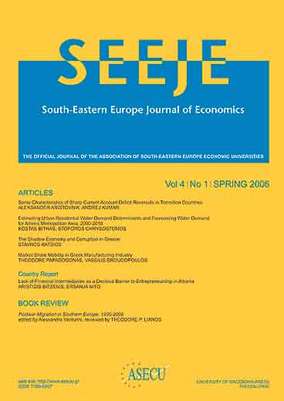The welfare cost of inflation in Greece
Part of : SEEJE ; Vol.10, No.1, 2012, pages 41-52
Issue:
Pages:
41-52
Abstract:
This paper measures the welfare cost of inflation for the case of Greece, using quarterly data for the period 1980Q1-1999Q4. Log-log and semi-log money demand functions are estimated using both OLS and Stock and Watson’s (1993) dynamic OLS method. These estimates show the welfare cost of a 10 percent inflation rate in the range of 0.59 percent to 0.91 percent of GDP.
Subject (LC):
Keywords:
welfare cost of inflation, inflation tax, inflation
Notes:
Περιέχει πίνακες, διαγράμματα και βιβλιογραφία, We are thankful to Dr. George Tavlas and Mr Pavlos Petroulas for their contribution to this paper, as well as two anonymous referees for their helpful comments., JEL Classification: E52
References (1):
- Anderson, Richard G. and Robert H. Rasche (2001), “The remarkable stability of monetary basevelocity in the United States, 1919-1999.” Federal Reserve Bank of St. Louis Working Paper,008A.Bailey, Martin J. (1956), “The welfare cost of inflationary finance.” Journal of Political Economy,64, 93–110.Boel, Paola and Gabriele Camera (2011), “The welfare cost of inflation in OECD countries.”Macroeconomic Dynamics, 1–35.Brissimis, Sophocles N., George Hondroyiannis, P.A.V.B. Swamy, and George S. Tavlas (2003),“Empirical modeling of money demand in periods of structural change: The case of Greece.”Working Papers 01, Bank of Greece.Elliot, G., Rothenberg, T. Stock, J., 1996. Efficient tests for an autoregressive unit root,Econometrica, 64, 813-836.Ericsson, Neil. R. and Sunil Sharma (1998), “Broad money demand and financial liberalization inGreece.” Empirical Economics, 23, 417–436.Friedman, Milton (1969), The Optimum Quantity of Money. In The Optimum Quantity of Moneyand Other Essays, Aldine Publishing Company.Hamilton, James D. (1994), Time Series Analysis. Princeton University Press.Ireland, Peter (2009), “On the welfare cost of inflation and the recent behavior of money demand.”American Economic Review, 99, 1040–1052.Lucas, Robert E., Jr. (2000), “Inflation and welfare.” Econometrica, 68, 247–274.Newey, Whitney K. and Kenneth D. West (1987), “A simple, positive semi- definite, heteroskedasticityand autocorrelation consistent covariance matrix.” Econometrica, 3, 703–08.Ng, S., Perron, P., 2001, Lag length selection and the construction of unit root tests with good sizeand power, Econometrica, 69, 1519-1554.Phillips, Peter C. B. and Pierre Perron (1988), “Testing for a unit root in time series regression.”Biometrika, 75, 335–346.Phillips, Peter C.B. and S. Ouliaris (1990), “Asymptotic properties of residual based tests forcointegration.” Econometrica, 58, 165–93.Sarantides, Stylianos and Erotokritos Varelas (1985), “Money anticipations and the demand formoney: The case of Greece.” European Journal of Political Economy, 1, 385 – 397.Serletis, Apostolos and Kazem Yavari (2004), “The Welfare Costs of Inflation in Canada and theUnited States.” Economics Letters, 84, 199-204.Serletis, Apostolos and Kazem Yavari (2005), “The Welfare Cost of Inflation in Italy.” AppliedEconomics Letters, 12, 165-168.Serletis, Apostolos (2007), The Demand for Money: Theoretical and Empirical Approaches,Springer.Serletis, Apostolos and Kazem Yavari (2007), “On the welfare cost of inflation in Europe.” AppliedEconomic Letters, 14, 111–113.Stock, James H. and Mark W. Watson (1993), “A simple estimator of cointegrating vectors in higherorder integrated systems.” Econometrica, 61, 783– 820.Yavari, Kazem and Apostolos Serletis (2011), “Inflation and welfare in Latin America.” OpenEconomies Review, 22, 39–52. 10.1007/s11079-009-9163-3.




